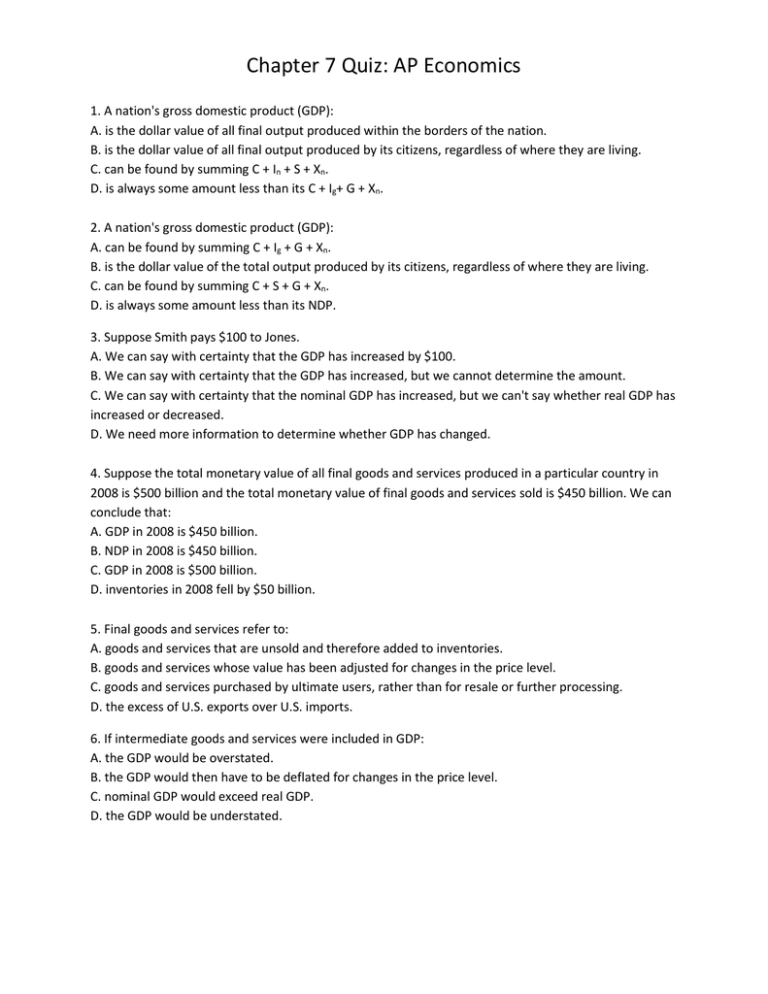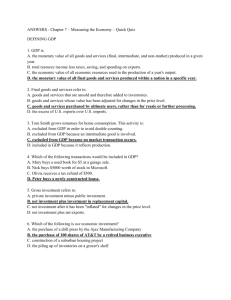Chapter 7 Quiz - King Miller's Wiki
advertisement

Chapter 7 Quiz: AP Economics 1. A nation's gross domestic product (GDP): A. is the dollar value of all final output produced within the borders of the nation. B. is the dollar value of all final output produced by its citizens, regardless of where they are living. C. can be found by summing C + In + S + Xn. D. is always some amount less than its C + Ig+ G + Xn. 2. A nation's gross domestic product (GDP): A. can be found by summing C + Ig + G + Xn. B. is the dollar value of the total output produced by its citizens, regardless of where they are living. C. can be found by summing C + S + G + Xn. D. is always some amount less than its NDP. 3. Suppose Smith pays $100 to Jones. A. We can say with certainty that the GDP has increased by $100. B. We can say with certainty that the GDP has increased, but we cannot determine the amount. C. We can say with certainty that the nominal GDP has increased, but we can't say whether real GDP has increased or decreased. D. We need more information to determine whether GDP has changed. 4. Suppose the total monetary value of all final goods and services produced in a particular country in 2008 is $500 billion and the total monetary value of final goods and services sold is $450 billion. We can conclude that: A. GDP in 2008 is $450 billion. B. NDP in 2008 is $450 billion. C. GDP in 2008 is $500 billion. D. inventories in 2008 fell by $50 billion. 5. Final goods and services refer to: A. goods and services that are unsold and therefore added to inventories. B. goods and services whose value has been adjusted for changes in the price level. C. goods and services purchased by ultimate users, rather than for resale or further processing. D. the excess of U.S. exports over U.S. imports. 6. If intermediate goods and services were included in GDP: A. the GDP would be overstated. B. the GDP would then have to be deflated for changes in the price level. C. nominal GDP would exceed real GDP. D. the GDP would be understated. 7. Which of the following is a final good or service? A. a haircut B. fertilizer purchased by a farm supplier C. diesel fuel bought for a delivery truck D. Chevrolet windows purchased by a General Motors assembly plant 8. Which of the following is an intermediate good? A. the purchase of gasoline for a ski trip to Colorado. B. the purchase of baseball uniforms by a professional baseball team. C. the purchase of a pizza by a college student. D. the purchase of jogging shoes by a professor 9. Tom Atoe grows tomatoes for home consumption. This activity is: A. excluded from GDP in order to avoid double counting. B. excluded from GDP because an intermediate good is involved. C. productive but is excluded from GDP because no market transaction occurs. D. included in GDP because it reflects production. 10. GDP can be calculated by summing: A. consumption, investment, government purchases, exports, and imports. B. investment, government purchases, consumption, and net exports. C. consumption, investment, wages, and rents. D. consumption, investment, government purchases, and imports. 11. Net exports are negative when: A. a nation's imports exceed its exports. B. the economy's stock of capital goods is declining. C. depreciation exceeds domestic investment. D. a nation's exports exceed its imports. 12. In calculating GDP, governmental transfer payments, such as social security or unemployment compensation, are: A. not counted. B. counted as investment spending. C. counted as government spending. D. counted as consumption spending. 13. The largest component of total expenditures in the United States is: A. net exports. B. government purchases. C. consumption. D. gross investment. 14. Transfer payments are: A. excluded when calculating GDP because they only reflect inflation. B. excluded when calculating GDP because they do not reflect current production. C. included when calculating GDP because they are a category of investment spending. D. included when calculating GDP because they increase the spending of recipients. 15. The gross domestic product for the above economy is: A. $584. B. $592. C. $609. D. $623. 16. Real GDP measures: A. current output at current prices. B. current output at base year prices. C. base year output at current prices. D. base year output at current exchange rates. Use the following table for a hypothetical single-product economy. 17. Refer to the above data. Nominal GDP in year 3 is: A. $100. B. $450. C. $225. D. $150. 18. Refer to the above data. Real GDP in year 3 is: A. $100. B. $450. C. $225. D. $150. 19. Refer to the above data. Nominal GDP in year 4 is: A. $320. B. $450. C. $225. D. $800. 20. Refer to the above data. Real GDP in year 4 is: A. $320. B. $450. C. $200. D. $800. KEY: 1. 2. 3. 4. 5. 6. 7. 8. 9. 10. 11. 12. 13. 14. 15. 16. 17. 18. 19. 20. A A D C C A A B C B A A C B D B B D D C







